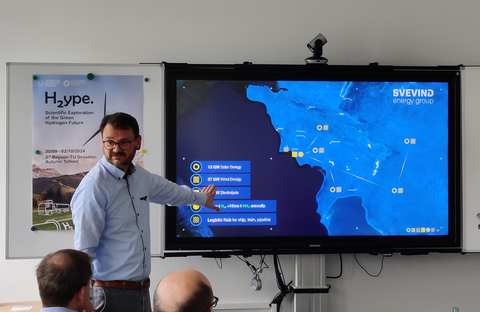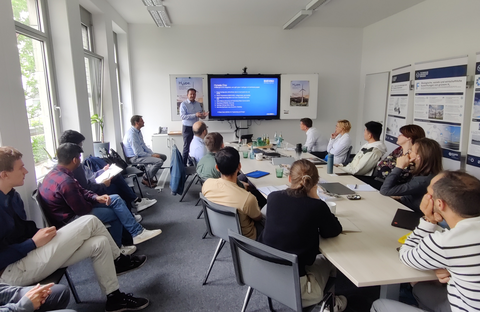Jun 28, 2024
SVEVIND Energy Experts Share Insights on Ambitious Green Hydrogen Project in Kazakhstan
Dr. Renè Pforte, Dr. Peter Bernhardt, and Mr. Raymond Kick, esteemed project developers from SVEVIND Energy, visited the Boysen-TU Dresden Research Training Group on June 11, 2024, to discuss their experiences and insights into the planning phase of one of the world’s most ambitious green hydrogen projects, “Hyrasia One”. SVEVIND Energy, a Dresden-based firm with 30 years of experience in renewable energy projects, is renowned for developing Europe’s largest onshore wind farm, “Markbygden 1101” in northern Sweden.
The lecture began with Dr. Pforte, Chief Business Development Officer at SVEVIND, introducing the company’s mission, emphasizing their dedication to sustainable development. He highlighted the strategic reasons behind selecting Kazakhstan for the green hydrogen project. This choice was driven by the region’s significant renewable energy potential and its strategic advantages in geographic, economic, and geopolitical terms, paralleling the MENA region, which is currently under exploration by researchers in Cluster E. He delved into the planning process, from initial site selection to gathering essential technical information, estimating potential energy generation, assessing economic feasibility, engaging stakeholders and government entities, and attracting investors. This comprehensive approach underscores the intricate planning required to launch such a ground-breaking initiative.

Dr. René Pforte, Chief Business Development Officer at SVEVIND
Dr. Bernhardt, Chief Technology Officer, followed by describing the various activities involved in the development phase. Given the unique nature of large-scale, stand-alone projects like “Hyrasia One”, he explained that SVEVIND closely collaborates with specialized firms e.g. for ngineering and environmental and social impact assessments. This cooperation necessitates meticulous communication and coordination, highlighting the complexity of managing such extensive projects. Mr. Kick, Process Engineer, provided an in-depth overview of the technical aspects of the planned green hydrogen and ammonia production plant. He discussed the design and positioning of critical components such as electrical grid, desalination plants, electrolysers, and ammonia generation facilities. Mr. Kick also elaborated on the design considerations, modelling challenges, and potential issues expected during development. Additionally, he explored various transportation options for green hydrogen, emphasizing the logistical intricacies involved.
In a detailed exploration of the project’s environmental and social dimensions, the team addressed the ongoing baseline monitoring campaigns, assessments and compensations aimed at minimizing potential impacts. Their thorough consideration of ecological and social factors underscores the commitment to responsible project development.
The session concluded with an engaging Q&A, where Dr. Pforte, Dr. Bernhardt, and Mr. Kick addressed technical, strategic, and general inquiries from the audience. They also offered to continue the dialogue via email, further demonstrating their willingness to bridge the gap between academic theory and practical application.
Overall, the visit provided valuable, application-based insights closely aligned with the research conducted at the Boysen-TU Dresden Research Training Group. We extend our gratitude to SVEVIND Energy for their contribution to bridging the gap between academia and industry, and we wish them success in their endeavour to advance the urgent sustainability transition through the “Hyrasia One” project.

